Microgrids are innovative solutions in the energy sector, addressing diverse challenges and offering localized energy distribution. Implementing microgrids can solve the problem of power outages, whether planned or unplanned, and subsequent grid blackouts, as a growing number of people are expressing concerns about the resilience and reliability of legacy power systems.
During emergencies such as power outages, grid failures, natural calamities, etc., the microgrids can run independently utilizing the local energy generation entities. The upcoming article will provide what microgrids are, their operating modes, the need for AI in microgrids, AI and blockchain integration in microgrids, examine challenges related to integrating AI, analyze their current market presence, and conclude.
What is a Microgrid?
A microgrid is a localized, small-scale electricity network that connects consumers to an electricity supply. Unlike traditional centralized grids, they operate independently or in conjunction with the larger grid.

Figure 1: Microgrid Block Diagram
They incorporate various distributed energy resources (DERs) such as photovoltaic cells, wind turbines, generators, fuel cells, energy storage systems, etc., and advanced control systems to enhance reliability, resilience, and sustainability.
Different Types
Microgrids are of three types based on the type of current they deal with:
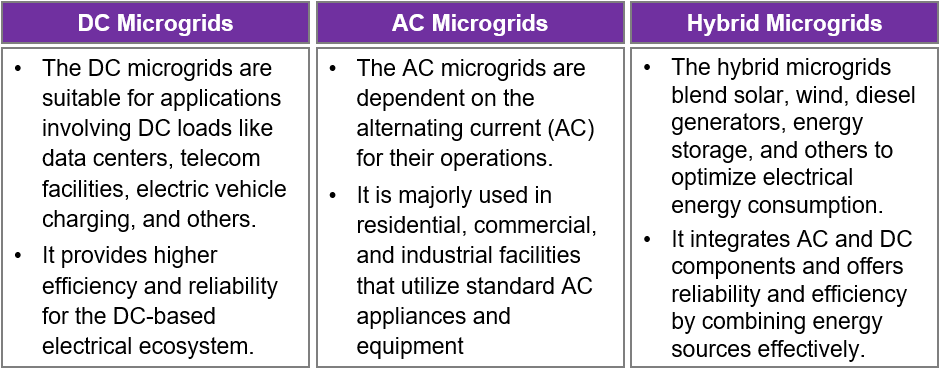
Figure 2. Types of microgrids
Operating Modes
Microgrids can be operated in two modes depending upon their connection with the main grid:
- Grid-Connected Mode: In grid-connected mode, a Microgrid interacts with the external grid to maintain local supply and facilitate power exchange. Here is a breakdown.
- Microgrids in this mode do not regulate grid voltage but manage power factor uniformly
- It operates in parallel to the company system without isolation, enabling power sharing and stability
- Grid-connected microgrids can export or trade surplus energy within the distribution network
- Islanded Mode: When faults occur in the main grid, causing abnormal conditions at the point of common coupling (PCC), microgrids are isolated from the main grid and continue to operate as islanded microgrids.
- The local frequency and voltage are regulated by the distributed renewable energy sources (RESs) (e.g., wind and solar PV) and energy storage systems (EESs)
- In microgrids, EESs are a critical element that maintains the energy balance, minimizes power fluctuations, and improves the reliability and system efficiency
- When the demand is high, then EESs are used to supply the power to microgrids
- EESs improve the voltage and frequency regulation of the islanded Microgrid
Need of AI
AI-transformed microgrids have increased their effectiveness, dependability, and environmental friendliness. It provides microgrids with various functionalities, as mentioned in the below figure
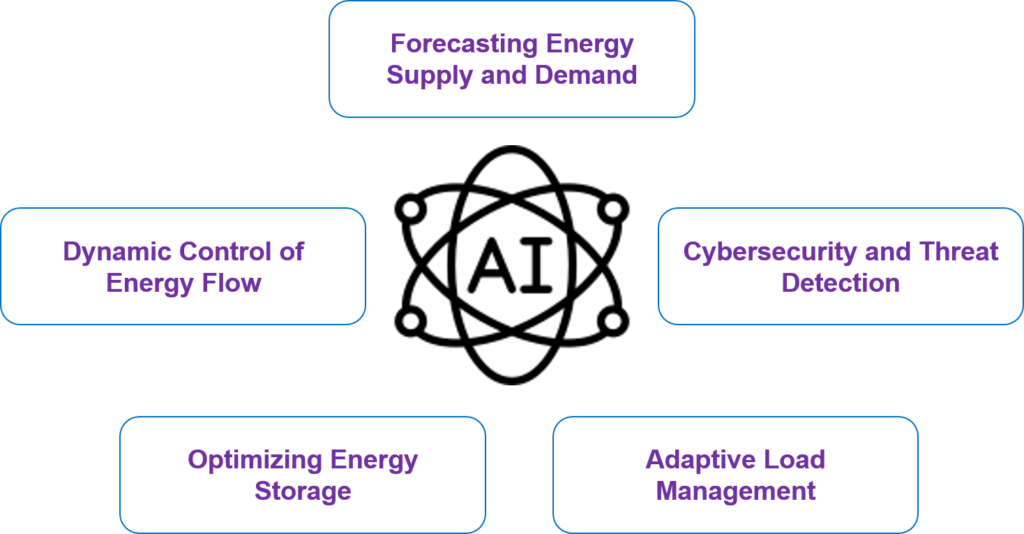
Figure 3: Need for AI in microgrids
- Energy Supply and Demand Forecasting:
Predictive models and analytics are used to allocate assets and analyze expected demand & supply fluctuations in electricity generation and consumption in the microgrid.
AI contributions: Microgrids use AI to strengthen supply and address demand fluctuations across the grid community.
Importance: Accurate forecasting of electricity intake, particularly for high-demand phases and during varying electricity consumptions.
- Managing Power Flow Dynamically:
Real-time analysis and manipulation structures for nonstop power tracking are essential in microgrid networks, optimizing circuit energy consumption.
AI Contribution: AI algorithms examine key statistics to maximize electricity flow in microgrids.
Importance: Dynamic control helps formulate combinations of multiple energy sources, such as solar panels, wind turbines, and batteries, to address changing energy demand and supply.
- Enhancing Cybersecurity:
Implement superior cybersecurity guidelines and threat detection strategies to guard the community from cyber-attacks and unauthorized access.
AI contribution: AI-powered systems observe, analyze, and mitigate cyber threats to microgrid operations.
Importance: Defending against cyberattacks on microgrids in various situations.
- Improving Energy Storage:
We can improve the system’s overall performance and flexibility by using algorithms and electricity control systems to increase microgrids’ energy storage strength and consumption.
AI contribution: Artificial intelligence algorithms will play a key role in offering better energy storage by optimizing power supply and demand.
Importance: Effective energy storage management increases flexibility, which helps lower costs.
AI and Blockchain Integration in Microgrids
Microgrids are made up of three layers: the physical layer, the control layer, and the information layer, which are described below in Figure 4.
Physical Layer: This layer includes the physical components and infrastructure that form the grid. It includes generators, energy storage systems, inverters, transformers, distribution lines, and loads.
Control Layer: This layer includes the software, algorithms, and control systems, which are responsible for managing and optimizing the assigned operation.
It collects the data from the information layer to perform the function or control several components.
Information Layer: This layer uses the data from the transactions to make energy sharing and management easier for everyone in the grid system.
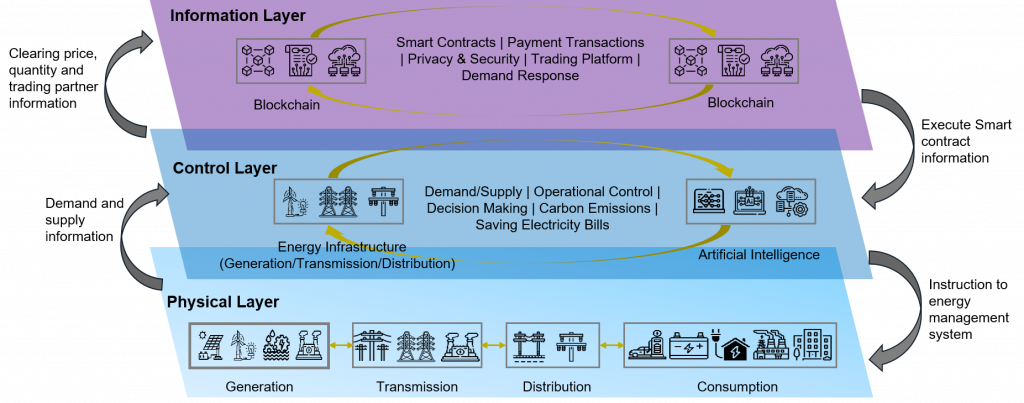
Figure 4: AI and Blockchain Integration in Microgrid Framework
The microgrid ensures that resources are used efficiently and energy is shared fairly by using data related to transactions. In the microgrid plan, smart technologies, such as AI and Blockchain, are mainly used to manage information and control things.
Blockchain technology offers various functionalities in the information layer, including Smart Contracts, Payment Transactions, Privacy & Security, Trading Platforms, and Demand Response. Further, the data exchange between multiple Blockchains can enhance interoperability, security, and efficiency. In the control layer, AI technologies provide capabilities such as Controlling Demand/Supply, Operational Control, Decision Making, Carbon Emissions, and Saving Electricity Bills.
Challenges in Integrating AI to Microgrids
Although AI integration in microgrids might solve many ground-level problems, integrating AI also comes with its own set of problems.
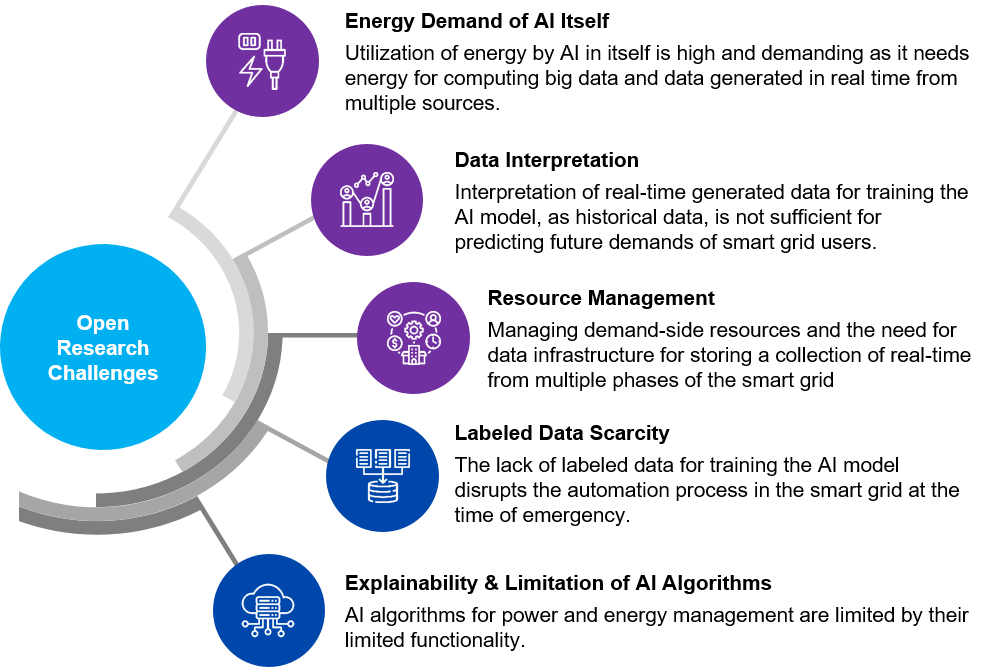
Figure 5: Challenges in Integrating AI to Microgrids
Market Insights
The market for microgrids surpassed US$17.8 billion in 2024 and is projected to expand at a compound annual growth rate (CAGR) exceeding 20.5% from 2024 to 2032, to account for US$95.3 billion.
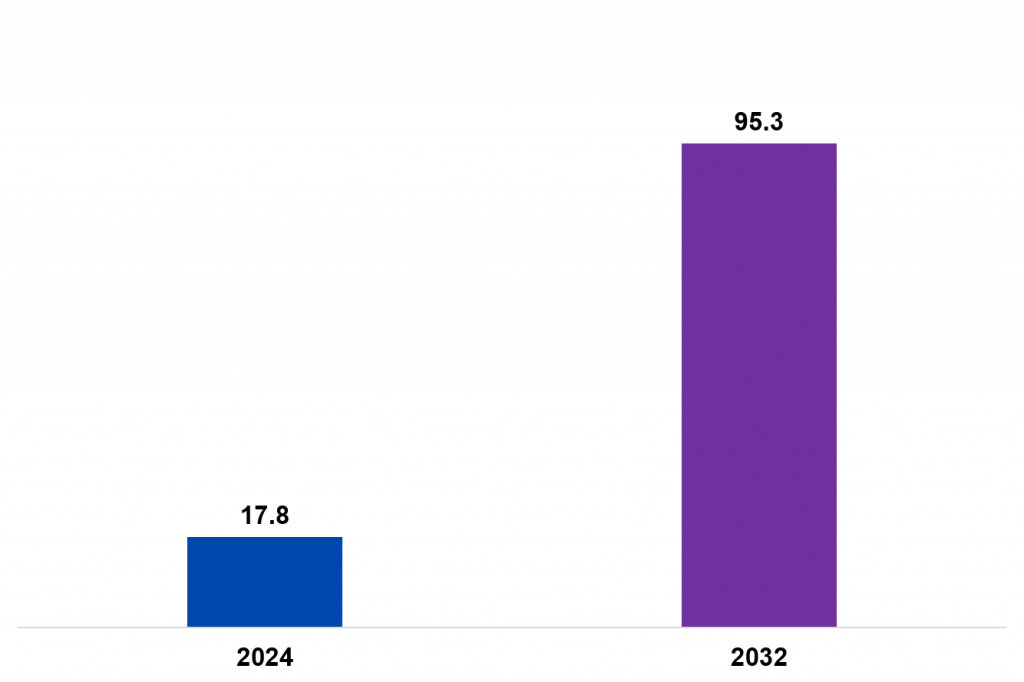
Figure 6: Microgrid market forecast (US Billions)
The market is being driven by increasing requirements for improved energy security and reliability, the growing demand for cleaner, more sustainable energy sources, and the rising need for cost-effective energy systems.
Prominent Players
Below are some companies that are involved in microgrid setup, management, and related services:
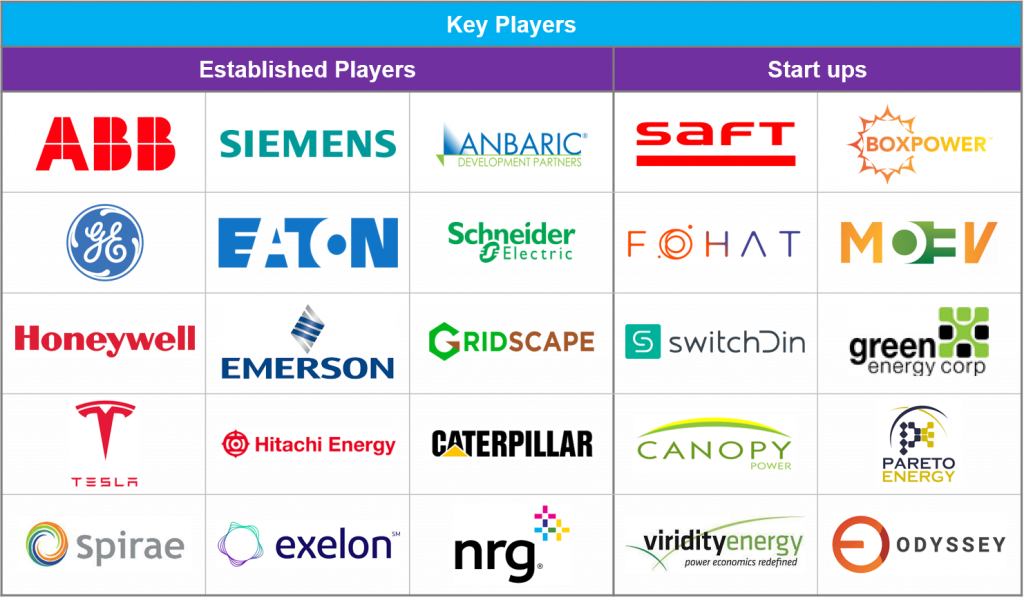
Figure 7: Important players in the Microgrid market
Recent Activities
Here are some news and insights related to microgrids.
| Department of Energy | In March 2024, DOE awarded US$9.5 Million for Iowa’s First Microgrid Project, Iowa’s Montezuma project, featuring a 3 MW solar installation and battery energy storage system, which aims to reduce energy costs for residents by up to 18% and lower utility transmission costs by 34%. |
| Sidewalk Infrastructure Partners | In March 2024, Alphabet spin-off Sidewalk Infrastructure Partners (SIP) launched Verrus, a data center concept built around battery ‘microgrids’: SIP has introduced a novel concept called Verrus for more flexible data center energy management. Verrus incorporates “microgrids” based on advanced, high-power batteries with software to allocate energy efficiently. |
| Advait Infratech Limited | In February 2024, Advait Infratech Limited unveiled India’s first Green Hydrogen microgrid system at the THDC India Limited (THDCIL) office complex in Rishikesh. The project features a 300 kW Green Hydrogen production plant coupled with a 70 kWh PEM Fuel Cell. Key components include a 300 kW Alkaline Electrolyser designed to generate 50 kg of high-purity hydrogen daily and a 24m3 storage tank operating at 30 bar pressure, ensuring continuous hydrogen supply for fuel cell operation, especially during nighttime. |
| Reon Energy | In December 2023, Reon Energy was awarded a contract to construct a microgrid featuring a 13.5 MW solar power plant and a 5.59 MWh battery energy storage system for Arabian Yemen Cement. The project will utilize Reon Energy’s SPARK Intelligent Energy Management Platform. It is anticipated to decrease energy costs by 20% and mitigate CO2 emissions from Arabian Yemen Cement’s operations. |
Conclusion
Microgrids are enhanced distributed power systems, providing clear economic and environmental benefits compared to expanding our legacy modern power distribution and management systems. However, the development of microgrid concepts and technologies requires considerable effort to resolve numerous economic, commercial, and technical challenges.
With advanced control systems and energy management algorithms, microgrids optimize energy flow and storage, ensuring independent operation, efficient power generation, and resilience. However, challenges such as cybersecurity threats and the integration of AI into microgrid systems remain. Interestingly, like smart grids, the future of technology is brighter.